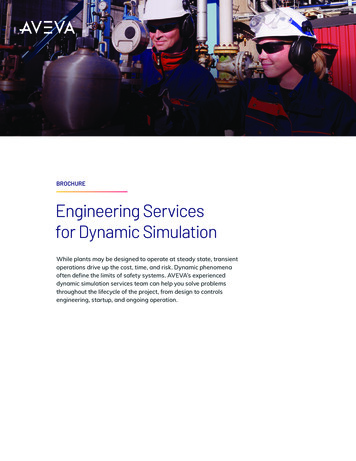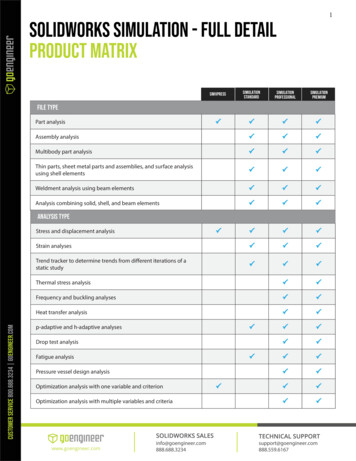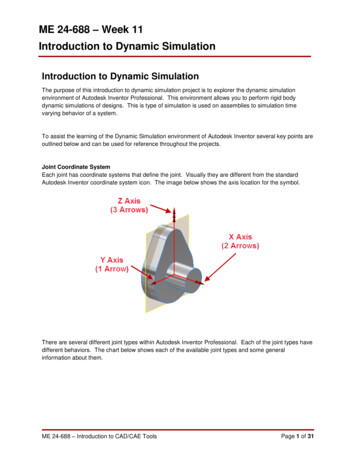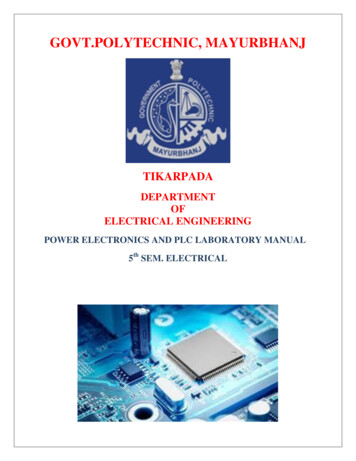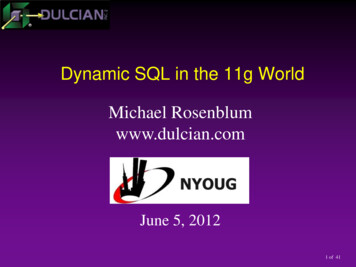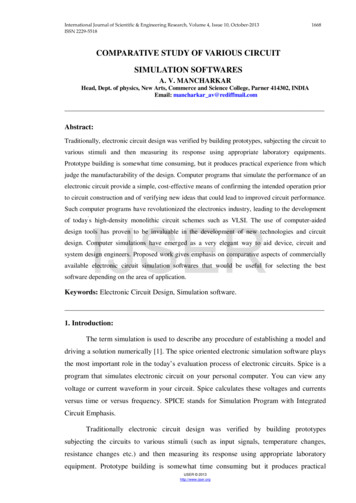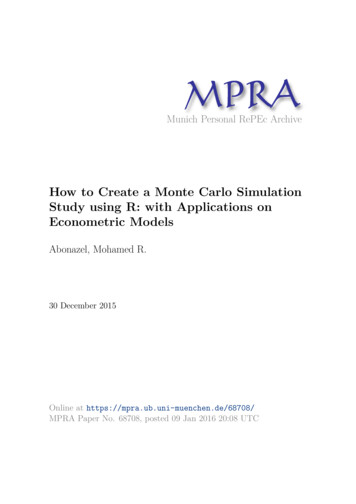
Transcription
Online ISSN 2234-1862Print ISSN 1738-1266Journal of Biosystems Engineering (2020) 74-7ORIGINAL ARTICLESimulation Study of Dynamic Characteristics of Hot Pepper Harvester&Seungmin Woo 1LESeokho Kang 1 & Junhee Kim 1 & Yeongsu Kim 1 & Yushin Ha 1Received: 5 August 2020 / Revised: 29 October 2020 / Accepted: 9 November 2020 / Published online: 15 January 2021# The Author(s) 2021RTICAbstractPurpose Determining the safety conditions of a hot pepper harvester to mechanize harvesting.Methods The dynamic characteristics of a hot pepper harvester were analyzed with the dynamic simulation program RecurDyn.Results The pepper harvester can climb a maximal slope of 25 under full loading conditions; the maximal allowable height of anobstacle over which the harvester can drive is 450 mm; the minimal rotation radius during a spin turn is 870 mm.Conclusions Considering its dynamic characteristics, the harvester can be applied on over 95% of domestic upland fields. Thesafety accident rate can be decreased with the use of the spin turn method. In conclusion, the dynamic characteristics aresufficiently safe for the domestic upland fields.AKeywords Dynamic characteristics . Dynamic simulation . Hot pepper harvester . Multipurpose driving platform . RecurDynlabor time per hectare in hot pepper cultivation is 2436 h, andthe harvest work accounts for 39.2% (954 h) of completeduration (RDA 2006). Owing to 2.0–5.4 relative metabolicrate, harvest work is classified as high-intensity labor.Therefore, many researchers have studied the mechanizationof harvest work.In 1995, Lee et al. conducted a survey on farmers to develop a hot pepper harvesting machine. Many farmers required aseparate harvesting machine rather than an attachment type,and the most frequently mentioned problem for the commercialization of the machine was the slope of land (Lee et al.1995). According to a survey, 39.4% of the 33 largest domestic hot pepper farms have flat fields, while 60.6% have fieldswith certain slopes (Choi et al. 2010). Therefore, harvestingmachines must be safely operable on fields with slopes.The previous studies have considered the driving safety ofharvesting machine for safe harvest work. However, the use ofagricultural machines can result in many types of accidents.According to the National Institute of Agricultural SciencesSurvey (2016), 50.5% of accidents occur during the transport,and 24.2% are caused by contact, collision, and strike. Inadditions, steep slopes, sharp curves, obstacles, and narrowworking spaces are significant environmental factors.According to an agricultural machine hazard analysis, therewere 519 agriculture machinery accidents and 65 causalities in2017 (KCA 2017). Moreover, a correlation between agricultural machinery traffic accidents and aging in rural society hasbeen proved through mathematical modeling (Kwon et al.2016). More than 70 accidents occurred during work, andTEDIntroductionRETRACHot pepper is one of the representative vegetables on theRepublic of Korea; it is used in its fresh, dry, or powderedform and accounts for 41.7% of used condiment vegetablesaccording to a food statistics survey (MAFRA 2017). Despitethe high demand on the condiment vegetable market, the cultivation area of hot pepper decreased from 50,000 ha in 2008to under 30,000 ha in 2018 (KOSIS 2018). Consequently, theproductivity decreased significantly, and hot pepper wasimported to satisfy the market demands. The import volumeincreased to approximately 110,000 tons in 2011, whichexceeded the domestic supply; the import volume is still increasing annually (KREI 2017).The most significant reasons for decreasing the cultivationarea are the long harvesting time and low mechanization (although the harvest requires high labor intensity). While themechanization rates of the plowing and rotary work and pestcontrol work were 99.8% and 82.8%, respectively, harvestwork did not score a sufficiently high rate to be included inthe statistics of mechanization rates (KOSIS 2017). The total* Yushin Hayushin72@knu.ac.kr* Seungmin Wookooger7571@naver.com1Kyungpook National University, 106, College of Agriculture,Building 3, 80, Daehak-ro, Buk-gu, Daegu, Republic of Korea
J. Biosyst. Eng. (2020) 45:333–340ParametersSpecificationsLength (mm)Width (mm)40001600Maximal loading (kg)200Working speed (km/h)1st42nd8Materials and MethodsFig. 2 Climbing angle analysisNX.UG 11, and the multipurpose driving platform wassketched with a caterpillar function in RecurDyn V8R5. Thespecifications of the hot pepper harvester are listed in Table 1,and the vehicle is presented in Fig. 1.The harvester was designed with caterpillar tracks;the left and right tracks were individually controllable.Kim and Park (2015) analyzed the dynamic propertiesof a semi-crawler type mini-forwarder with a simplifiedmodel, which can be applied to computational simulations. In the simulation method in this study, the harvester was also simplified to reduce the computationsand facilitate the simulations. All simulations were conducted with a driver and in empty and fully loadedstates.TEDmore than 160 traffic accidents were caused with cultivatorsand tractors. The types of accidents included rolling up,crashes, falls, hits, crushing, and rolling over. Consideringthe environmental factors and to prevent agricultural machinery accidents, hot pepper harvesting machine should be safelyoperable under a variety of conditions.In this study, the dynamic characteristics of a hot pepperharvester were simulated to evaluate its driving safety. Theworkable maximal slope at individual work speed, tiltingand pitching analysis, obstacle collision analysis, and minimalrotation radius were analyzed. The investigated hot pepperharvester consisted of the driving part (multipurpose drivingplatform) and the harvesting part.C6002090TI1900Ground clearance (mm)Weight with driver (kg)RHeight (mm)ATable 1 Specificationsof the hot pepperharvesterLE3343D Modeling of Hot Pepper HarvesterWorkable Maximal Slope at Individual Work SpeedRETRACThe 3D modeling program NX.UG (ver 11, Siemens,Germany) and dynamic simulation program RecurDyn(V8R5, FunctionBay, Republic of Korea) were used for thedynamic simulation. The harvesting part was sketched withFig. 1 Hot pepper harvesterBecause upland fields can exhibit many different slopes,the maximal allowable slope angle for the hot pepperharvester was determined. As shown in Fig. 2, slopeswere applied to the simulated ground, and the simulation was conducted at working speeds of 4 and 8 km/hin the empty and fully loaded states. The plain-slopeground was built with RecurDyn. Because actual fieldexhibit unpaved roads, friction coefficient 0.5 was applied to each surface pavement based on the study ofLim and Choi (2010) (Table 2).Table 2Friction coefficient by surface type (domestic standard)Condition typeDryHumidityVery .70.50.70.60.40.40.60.40.30.30.30.30.20.2
Table 3 Domesticupland fields distributionby slope335Slope ( )Area (ha)Ratio (%)0 0.90.9 3.1540,257142,5256.6723.643.15 6.75285,78247.396.75 13.513.5 27106,61624,23117.684.0227 4535720.59LEJ. Biosyst. Eng. (2020) 45:333–340TICTable 3 presents the results of a survey on distribution areasbased on the slopes of domestic upland fields (RDA 2011). Toevaluate the workability of the hot pepper harvester on domestic upland fields, the simulation and survey results werecompared.Fig. 4 Free body force diagramA(the height of the center of gravity (mm)), θ (the rollangle (degree)), L (the width of vehicle (mm)), FLateral(the lateral force (N)) and NF (the normal reaction force(N)). LLtan θ ¼; θ ¼ tan 12h2hAs the roll angle is increasing, the resisting moment produced by the gravitational force decreases because of themovement of the mass toward the wheel. When gravitationalforce is hard to hold the vehicle attachment to the ground, thewheel starts to tip and begin to roll. The roll angle is proportional to the width of the vehicle and inversely proportional tothe height of center of gravity.ETRACTEDFig. 3 represents the tilting (longitudinal direction) andpitching (lateral direction) analysis of the hot pepperharvester. A slope was added when the ground wasturned over; the maximal allowable angle at a specificpoint was determined exactly before the tracks of thehot pepper harvester lost contact to the ground.Because the driver’s seat was on the right side andthe loading bay was at the rear, the hot pepper harvesterhad different weight distributions at the front, rear,right, and left. Thus, separate analyses were conducted.Fig. 4 represents the free body force diagram actingon a vehicle when the ground is turning over. Themaximal roll angle can be described by the ratio ofthe moments arising from lateral and gravitationalforces. The gravitational force always acts downwardto hold the vehicle against the ground and can be theweight of the vehicle in this case. And the maximal rollangle can be expressed as W (the vehicle weight (N)), hRTilting and Pitching AnalyzeRFig. 3 a Tilting analysis, bPitching analysis(a)(b)
J. Biosyst. Eng. (2020) 45:333–340LE336TIC(a) Empty stateRFig. 5 Obstacle collision analysisCTEDFig. 5 shows the results of the obstacle collision analysis,conducted with RecurDyn V8R5. The hot pepper harvester was driven on flatland and rough and steep paths.Therefore, an obstacle collision analysis of the drivingstability was conducted. The hot pepper harvester drovewith one side track over differently sized obstacles onthe ground. The size of the obstacle was defined as theheight from the ground to the top of the obstacle.Subsequently, the maximal allowable size of the obstacle over which the hot pepper harvester could drive, andthe roll angle for each obstacle size was determined.AObstacle Collision Analysis(b) Full loading stateFig. 7 The maximal slope analysis results. a Empty state. b Full loadingstateMinimal Rotation Radius Determined with DifferentRotation MethodsRETRAThe hot pepper harvester could control its right and left caterpillar tracks individually. Three rotation methods (soft turn,spin turn, and brake turn) were applied to reduce the risk of(a)Fig. 6 Rotation methods (a Soft turn, b Spin turn, c Brake turn)(b)(c)
337CLEJ. Biosyst. Eng. (2020) 45:333–340ARmaximal slope angle was 35 at all work speeds, andthe hot pepper harvester could not climb a slope of over35 . In fully loaded state, the maximal slope angle was25 at all work speeds.According to Table 3, around 95% of domestic uplandfields have slope angles of less than 13.5 , and 99% haveslope angles of less than 27 . Therefore, the hot pepper harvester can be applied to 95% of domestic upland fields in thefully loaded state (200 kg).TEDcollision and to determine the minimal allowable rotation radius at which the crops were not damaged during the fieldwork (Fig. 6).A soft turn is defined based on the speed difference between the right and left tracks; a spin turn is definedbased on the different rotation directions of the right and lefttracks; and in a brake turn, one side track keeps running whilethe other side track brakes. The minimal rotation radius wasanalyzed by dividing the work speed into first and secondstages.TIFig. 8 Tilting analysis resultsResults of Tilting and Pitching AnalysesResults and DiscussionCAnalysis Results of Workable Maximal SlopeRETRAFig. 7 present the simulation results of the maximal workableslope angle of the hot pepper harvester with a driver for different work speeds and loading states. In the empty state, theFig. 9 Pitching analysis for empty stateThe results of the tilting analysis in the empty and fully loadedstates are shown in Fig. 8. The maximal angle was reachedshortly before the sharp differential slope of the curve.Regarding the tilting analysis results, the tracks lost contactto the ground when the slope reached 53 on the right side and57 on the left side in the empty loading state. In the fully
338Empty5357Fully loaded5255EmptyFully loaded58606052Roll angle (deg)1002005.010.130014.640050019.926.9the ground and roll-over occurred. Therefore, the hot pepperharvester could drive the obstacle height of below 500 mm.Moreover, the roll angles at each obstacle height were constant in the empty and fully loaded states.Analysis Results of Minimal Rotation RadiusFig. 10 present the simulation results of the minimal allowablerotation radius in different rotation methods. It was determined by calculating the distances between the start and endpoints of the outer track of the hot pepper harvester, in theempty and fully loaded states. The results of each rotationmethod are shown in Table 7.For the soft turn, the hot pepper harvester had a 2000-mmrotation radius for the first gear shift and 3000 mm for thesecond gear shift. The results of both loading bay conditionswere equal. For the spin turn, the rotation radius was 900 mmwith empty loading bay and 870 mm when the loading baywas fully loaded with crops. For the brake turn, the rotationradius was 600 mm for both loading conditions. The resultsand gear shift were not correlated during the spin and braketurns, whereas they were correlated during the soft turn.TEDloaded state, the tracks lost to the ground when the slopereached 52 on the right side and 55 on the left side.Owing to the driver’s seat, the right and left sides had differentweight distributions. Positioning the driver’s seat on the leftside caused the center of gravity to lean to one side.Apparently, the left side of the hot pepper harvester had anadvantage of 3 to 4 over the right side.The results of the pitching analysis for the empty and fullyloaded states are presented in Fig. 9. In the empty state, rollover occurred when the slope reached 58 on a downhill pathand 60 on an uphill path. In the fully loaded state, roll-overoccurred when the slope reached 60 on a downhill path and52 on an uphill path. Because the hot pepper harvester keptfront and rear center of gravity balanced, there were no greatdifferences between the downhill and uphill case results in theempty state. However, when 200 kg crops were loaded on theloading bay, the center of gravity moved to the rear position.This triggered the roll-over 8 earlier than the empty state onan uphill path (Table 4).Obstacle height tatesTIAnalysisTable 6 Roll angle byobstacle height in fullloading stateRTilting and pitching analysis results in different statesATable 4J. Biosyst. Eng. (2020) 45:333–340CResults of Obstacle Collision AnalysisRETRAThe simulations were conducted until the hot pepper harvesterexperienced roll-over and could not go forward. Tables 5 and6 present the maximal roll angles of the unloaded and fullyloaded hot pepper harvester for each obstacle heightrespectively.According to Tables 5 and 6, the roll-over occurred whenthe obstacle was 500 mm high. It seems that when the machine drove the obstacle height of 500 mm, the roll center(RC) of the machine gets higher than the center of gravity(CG) of the machine. It caused the weight transferred aboveTable 5 Roll angle byobstacle height in emptystateObstacle height (mm)Roll angle (deg)1002003004005004.99.914.018.826.1Fig. 10 Calculation of minimal rotation radius
J. Biosyst. Eng. (2020) 45:333–340The minimal rotation radius in each different methodThe minimal rotation radius (mm)1st gear shift2nd gear shiftSoft turnEmpty20003000Fully loaded20003000Spin turnEmptyFully loaded900870Brake turnEmpty1200Fully loaded1200Compliance with Ethical StandardsLEConflict of Interest The authors declare that they have no conflict ofinterest.ReferencesChoi, Y., Jun, H. J., Lee, C. K., Lee, C. S., Yoo, S. N., Suh, S. R., & Choi,Y. S. (2010). Development of a mechanical harvesting system forred pepper (I) surveys on conventional pepper cultivation and mechanization of pepper harvesting, Journal of biosystems engineering.,35(6), 367–372 (in Korean, with English abstract). https://doi.org/10.5307//JBE.2010.35.6.367.Kim, J. H., & Park, S. J. (2015). Running stability analysis of the semicrawler type mini-forwarder by using a dynamic analysis program.Journal of Korean Forest Society, 104(1), 98–103 (In Korean, withEnglish abstract). https://doi.org/10.14578/JKFS.2015.104.1.98.Korea Rural Economic Institute (KREI). 2017. A Survey on the mixeddistribution of red pepper powder and a study on the improvementplan (In Korean).Korean Consumer Agency (KCA). (2017). Hazard information analysisof agricultural machinery (In Korean).Korean Statistical Information Service (KOSIS). (2017). Field cropmechanization rate (In Korean).Korean Statistical Information Service (KOSIS). 2018. Cultivated Areaof Rice and Pepper in 2018 (In Korean).Kwon, J. S., Yang, H. A., & Yoo, D. I. (2016). An analysis on the effectof aging farmers on agricultural machinery accidents. KoreanJournal of Agricultural Science, 32(1), 57–62 (in Korean, withEnglish abstract).Lee, C. H., Park, S. J., Kim, C. S., Rhee, J. Y., Kim, M. H., & Kim, Y. H.(1995). Determination of development strategy for a pepper harvester. Korean Society for Agricultural Machinery, 20(1), 22–35 (inKorean, with English abstract).Lim, C. S., & Choi, Y. W. (2010). The experimental study on the transientbrake time of vehicles by road pavement and friction coefficient.Korean Society of Civil Engineers, 30(6), 587–597 (In Korean, withEnglish abstract).Ministry of Agriculture, Food and Rural Affairs (MAFRA). (2017). 2017Food Information Statistics (In Korean).RETRACTEDIn this study, the dynamic characteristics of hot pepper harvester were analyzed. According to the results of the dynamicsimulations, the maximal safe path slope for the harvesterwithout crops on the loading bay was 35 ; the maximal slopewas 25 when the loading bay was fully loaded with crops.Considering the slope distribution of domestic upland fields inthe Republic of Korea, the fully loaded hot pepper harvestercan be driven on 95% of domestic upland fields.The loading conditions did not have a great effect on the tiltingresults. The maximal angle was 53 for the right side and 57 forthe left side in the empty loading state and 52 for the right side and55 for the left side in the fully loaded state. The position of thedriver’s seat introduced a small difference between the maximalangles of the right and left sides. By contrast, the loading conditiondid not affect the tilting results. Regarding the pitching analysis,the loading condition had a great effect on the results. The maximalangle was 58 in the empty loading state and 60 in thefully loaded state for the downhill path and 60 in theempty loading state and 52 in the fully loaded state forthe uphill path. Caution is required to prevent the harvester from rolling over when it is moving uphill.According to the results of the obstacle collision analysis,the maximal allowable height of the obstacle was below500 mm. When the hot pepper harvester faced an obstaclewith a 500-mm height, the RC of the machine gets higher thanthe CG of the machine. It caused the roll-over, and the angle atthe start of the roll-over was 26 . Compared to the tiltinganalysis results, the working speed affected the movementand the results of the obstacle collision seem more realistic.The spin turn exhibited the shortest rotation radius(900 mm in the empty state and 870 mm in fully loaded state).The soft turn resulted in rotation radius of 2000 mm in the firstgear shift and 3000 mm in the second gear shift in both emptyand fully loaded states. Furthermore, the brake turn resulted inrotation radius of 1200 mm in the empty and fully loadedstates. By using the spin turn, the hot pepper harvester canbe operated without hurting crops, and the collision accidentsrate can be minimized.CConclusionsOpen Access This article is licensed under a Creative CommonsAttribution 4.0 International License, which permits use, sharing, adaptation, distribution and reproduction in any medium or format, as long asyou give appropriate credit to the original author(s) and the source, provide a link to the Creative Commons licence, and indicate if changes weremade. The images or other third party material in this article are includedin the article's Creative Commons licence, unless indicated otherwise in acredit line to the material. If material is not included in the article'sCreative Commons licence and your intended use is not permitted bystatutory regulation or exceeds the permitted use, you will need to obtainpermission directly from the copyright holder. To view a copy of thislicence, visit esRRotation methodFunding This work was supported by the Technology InnovationProgram (Project No. PJ2003975, development of intelligent crawlerbased traveling platform for multipurpose farming) and funded by theMinistry of Trade, Industry & Energy (MOTIE, Republic of Korea) andKorea Evaluation Institute of Industrial Technology (KEIT, Republic ofKorea).ATable 7339
340J. Biosyst. Eng. (2020) 45:333–340Rural Development Administration (RDA). (2011). Soil classificationand commentary in Korea. Reference No. 11-1390802-000391-01.Suwon, Republic of Korea: National Institute of AgriculturalSciences (In Korean).Rural Development Administration (RDA). (2016). Risk assessment byanalyzing safety accident cases of agricultural machinery (InKorean).RETRACTEDARTICLENational Institure of Agricultural Sciences (NIAS). (2016). Risk assessment by analyzing safety accident cases of agricultural machinery.New Delhi: NIAS (in Korean).Rural Development Administration (RDA). (2006). Development of harvest and postharvest on high quality processing technologies foronce-over-harvest red pepper (In Korea).
mechanization rates of the plowing and rotary work and pest control work were 99.8% and 82.8%, respectively, harvest work did not score a sufficiently high rate to be included in the statistics of mechanization rates (KOSIS 2017). The total labor time per hectare in hot peppercultivation is2436h,and the harvest work accounts for 39.2% (954 h .
